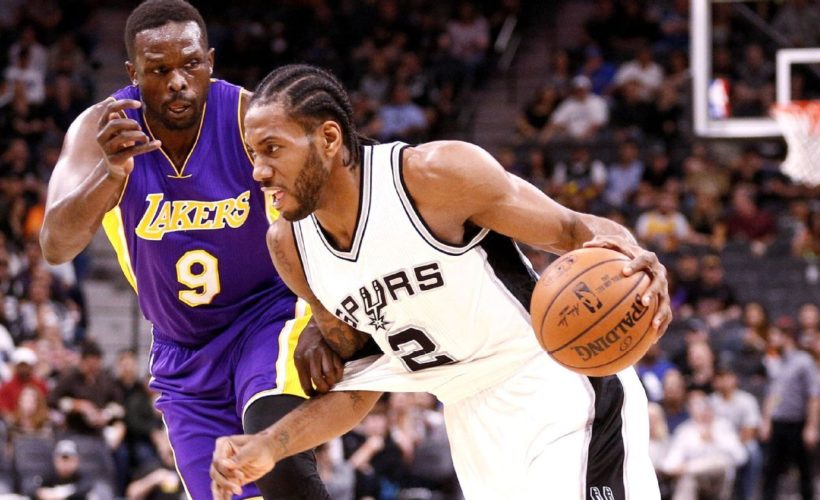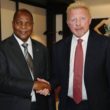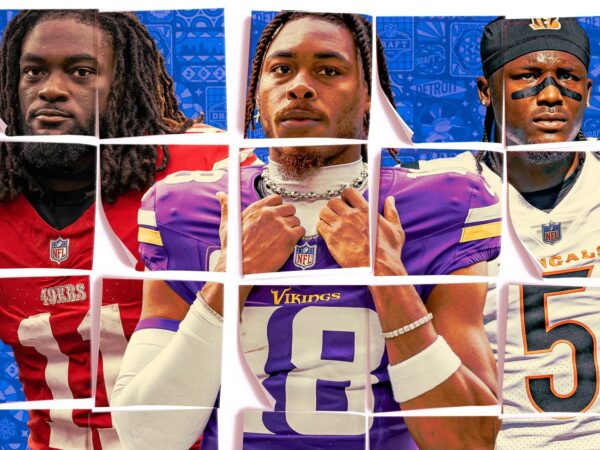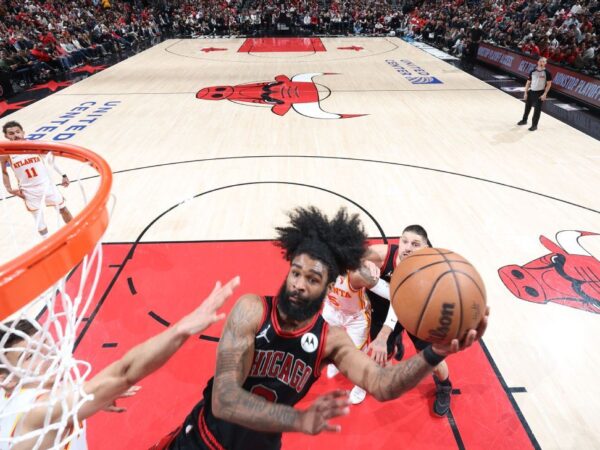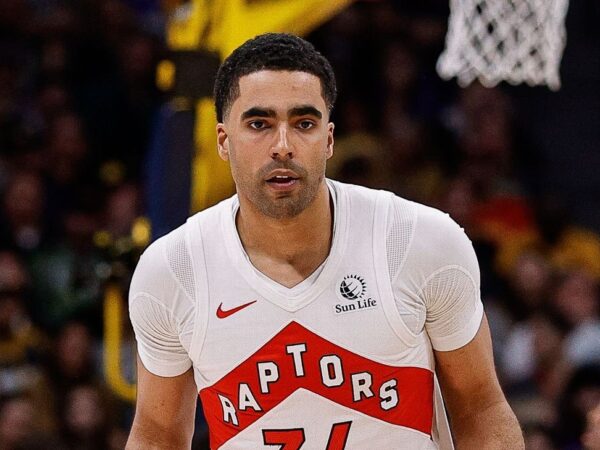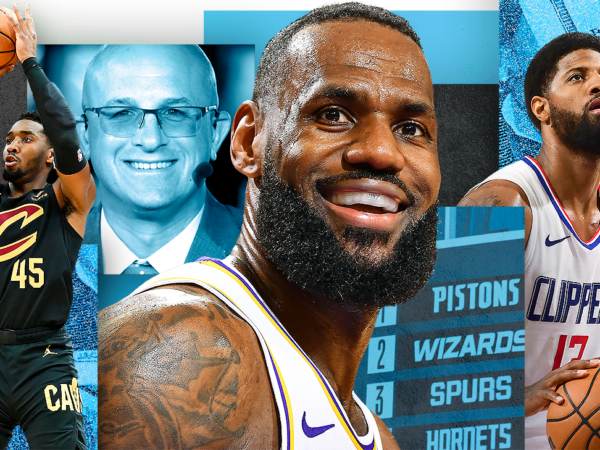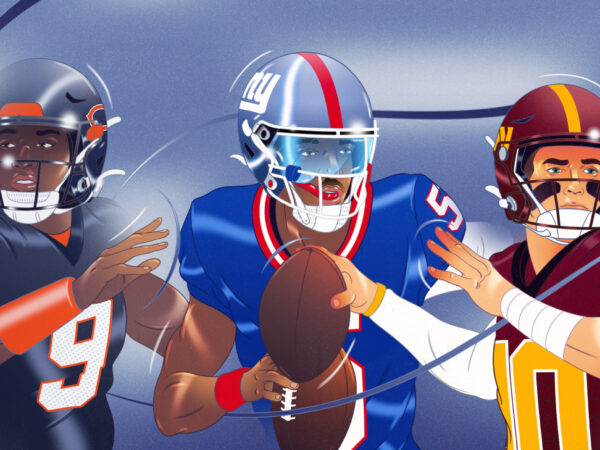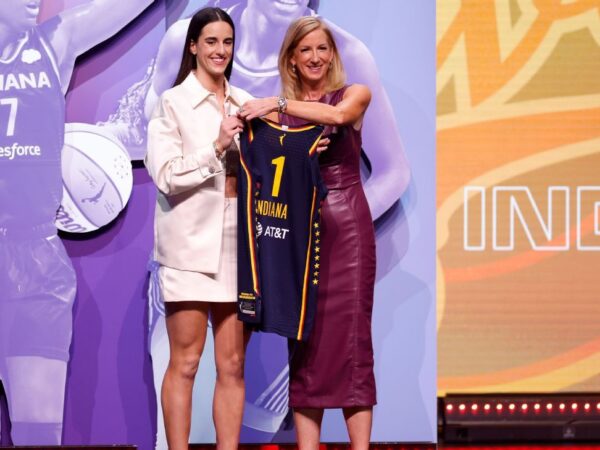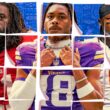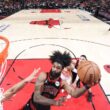Kawhi Leonard wants to leave the San Antonio Spurs, and Los Angeles is at the center of his trade preferences, according to a report by ESPN’s Chris Haynes and Adrian Wojnarowski.
What trades work for the All-Star forward? Our NBA Insiders give their best seven deals.
Lakers get: Kawhi Leonard
Spurs get: Lonzo Ball, Luol Deng, Kyle Kuzma
Magic get: Joffrey Lauvergne, 2020 Lakers second-round pick, $1.7 million cash (from Lakers)
Kevin Pelton: While the Lakers can’t offer San Antonio the kind of future picks that other teams can in a Leonard trade, they could offer promising young talent. This deal would work with either Ball or Brandon Ingram, the most recent two No. 2 overall picks, depending on how the Spurs value the two prospects.
Despite the focus on his poor shooting (42 percent on 2s, 30.5 percent on 3s), Ball rated well by advanced metrics as a rookie because of his versatile contributions. His elite court vision translated into a high assist rate and Ball was an outstanding rebounder for a point guard. He was also an active team defender who rated third among point guards in the defensive component of ESPN’s real plus-minus.
Spurs guard Dejounte Murray was one of the two point guards to rate better defensively than Ball, and a Murray-Ball backcourt would have the potential to be one of the NBA’s best on defense. An All-Rookie first team pick, Kuzma averaged 18.6 points per 36 minutes as a rookie, proving a dangerous 3-point shooter with the ability to create off the dribble.
As the price for getting both Ball and Kuzma, San Antonio would have to take on the final two seasons of Deng’s contract, which would cut into the team’s 2019 cap space. It’s possible, however, that the Spurs could rehabilitate Deng into a rotation player and salvage some value from his deal.
To make the trade work with Ball, the two teams would have to find a third partner to take on Lauvergne’s salary (under the assumption he picks up his 2018-19 player option). The Magic are an ideal candidate because they currently have enough cap space to take on Lauvergne’s contract but are unlikely to use cap space once the league year turns over after the July moratorium. So the only cost of adding Lauvergne would be his actual salary, which the Lakers would cover with cash.
76ers get: Kawhi Leonard and Derrick White
Spurs get: Robert Covington, Markelle Fultz, and the No. 10 pick
Bobby Marks: There are two questions that the 76ers’ front office has to ask about this type of deal:
-
Can they sign Leonard (or a similar player) as a free agent in 2019 using cap space without sacrificing assets?
-
Are they confident Leonard will commit long term?
Before the first question is answered, Philadelphia will need to rely on coach Brett Brown and his relationship with Leonard from his days as an assistant in San Antonio. Because Philadelphia is restricted in what it can offer Leonard in an extension before free agency (four years, $107 million; six months after he is acquired), both sides would be relying on a handshake agreement before the trade is completed. Essentially, the Sixers would be risking three assets because they trust Leonard.
If the risk is warranted, Philadelphia would still have $26 million in room in 2018 and a lineup featuring Leonard, Ben Simmons, Dario Saric and Joel Embiid, plus its own first-round pick (No. 26). Philadelphia could also move veteran Jerryd Bayless and its own first to a team with room and see its cap space increase to $34.3 million, good enough to target LeBron James or Paul George.
The 76ers can take the same approach and roll over room to 2019 with $28 million in space.
Remember, as the Lakers have learned, cap space is no guarantee of signing an All-NBA-level player. For San Antonio, trading Leonard would be the last resort if the relationship between the organization and player cannot be repaired.
This trade would accomplish three things for San Antonio: It would send Leonard to the Eastern Conference; the Spurs would remain competitive with three players who can help now; and the Spurs could have $27 million in 2019 to add players to surround LaMarcus Aldridge, Patty Mills, Murray, Fultz, Covington and two first-round picks in 2018 (the Lakers’ first and their own).
Celtics get: Kawhi Leonard
Spurs get: Kyrie Irving and Boston’s 2018 first-round pick (plus whatever other picks get the deal done)
Amin Elhassan: This is an aggressive play for Leonard, to be sure, but in a league increasingly favoring offenses that are predicated on preventing ball-stopping, while highly valuing the ability to switch everything defensively, it’s not hard to see how this is a no-brainer for Boston.
Leonard is the poster child for offensive efficiency, and with a lineup of 6-foot-8-plus athletes across the board, Boston would boast a deep enough, well-coached, flexible roster that could legitimately contend with the Golden State Warriors.
Pending the physical, the Celtics would be best served by aggressively pursuing Leonard, going so far as to entertain adding additional picks (up to and including the Kings pick owed from the Jayson Tatum deal last June). Re-signing Marcus Smart would become a priority, and the return of Gordon Hayward would provide some of the playmaking lost by Irving’s departure.
Heat get: Kawhi Leonard and Patty Mills
Spurs get: Goran Dragic, Josh Richardson, Justise Winslow and Bam Adebayo
André Snellings: The Heat can put together an intriguing mix of an All-Star point guard and three young players with upside in exchange for Leonard and Mills, whose outsized salary is guaranteed for three more years.
Dragic, a Spurs draftee in 2008 who was traded to Phoenix, is a proven producer at the Spurs’ biggest position of weakness. His aggressive scoring style with a strong jumper and pick-and-roll game would mesh well with LaMarcus Aldridge. Adebayo came out of the 2017 lottery with an impressive rookie season and would give the team a young, talented big man to develop behind the aging Pau Gasol.
Winslow and Richardson are both Spurs-style wings — long, athletic and defensive-minded. Both would be significant upgrades from what the Spurs currently have on the wing, and Winslow in particular has the tools to potentially replicate Leonard’s defensive contributions from his early years.
Raptors get: Kawhi Leonard and Rudy Gay
Spurs get: DeMar DeRozan, OG Anunoby and Pascal Siakam
Note: Get the full list of Raptors trades here
André Snellings: The Raptors aren’t good enough as currently constituted, and LeBron is their personal kryptonite (if he stays in the East). DeRozan’s game is built on driving and the midrange, and LeBron is just bigger and stronger, with the ability to prevent him from doing what he wants to do.
Leonard, on the other hand, is much bigger and athletic enough to go at LeBron one-on-one. Plus, Leonard is a legit top-five MVP candidate when healthy. Even if he won’t commit to Toronto long term, it’s worth the swing for a Finals run. (Gay would need to opt into his $8.8 million contract for this trade to work).
In return, the Spurs get an excellent scoring wing in DeRozan as a lieutenant to LaMarcus Aldridge, and both Anunoby and Siakam are young talents who fit the Spurs’ mold. Coach Gregg Popovich could likely turn them into borderline stars.
Blazers get: Kawhi Leonard, Derrick White
Spurs get: CJ McCollum, 2019 first-round pick
Jeremias Engelmann: Portland is on the wrong side of two consecutive first-round playoff sweeps and would certainly welcome a new face in its starting lineup, especially an All-Star wing and Defensive Player of the Year in Kawhi. The potential risk — if Leonard isn’t happy with the Spurs of all teams, can he be happy somewhere else? — is significantly outweighed by the potential upside.
In a vacuum, the Spurs don’t do this trade, as McCollum doesn’t have the impact of Leonard on either side of the court. But with Leonard and the Spurs on such uncertain terms, San Antonio’s hand is a bit forced. While McCollum had a bit of a down year, he’s still one of only 14 players who scored 20 PPG while being younger than 27. From a pure impact standpoint, McCollum generally ranks in the top-40 in multiyear regularized adjusted plus-minus (RAPM).
McCollum’s biggest weakness, defensive impact, is something that coaching has been shown to have a large influence on. So what better team for him to play on than one that finished top three in defensive rating for six consecutive years? And with how many gems the Spurs have found late in the draft, Portland’s future first-round pick — expected to be in the low 20s — should be a welcome addition to the deal.
Destination: Boston Celtics
Celtics get: Kawhi Leonard and Patty Mills
Spurs get: Gordon Hayward and Terry Rozier
André Snellings: Hayward is a selfless, do-everything wing who fits the Spurs’ style and can be the co-leader on offense with LaMarcus Aldridge. Meanwhile, Rozier showed that he is ready right now to be a starting lead guard on a playoff team. The Spurs have a weakness at point guard, a lack of players who can create shots for themselves and teammates and a complete dearth of perimeter scoring. This deal gives them two players who fill those needs and fit with the rest of the roster.
The Celtics would undoubtedly hate to lose Hayward, but Leonard is a clear upgrade in talent and makes them championship contenders right now. Leonard (when healthy) gives Boston a bona fide MVP candidate who can match up with any superstar wing in the league, slotting in perfectly next to Kyrie Irving, Al Horford, Jaylen Brown and Jayson Tatum. In this positionless NBA, that would be their answer to the Warriors’ Hamptons 5 lineup.
Source:ESPN

